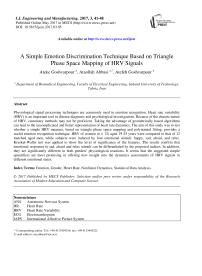A Simple Emotion Discrimination Technique Based on Triangle Phase Space Mapping of HRV Signals
Автор: Ateke Goshvarpour, Ataollah Abbasi, Atefeh Goshvarpour
Журнал: International Journal of Engineering and Manufacturing(IJEM) @ijem
Статья в выпуске: 3 vol.7, 2017 года.
Бесплатный доступ
Physiological signal processing techniques are commonly used in emotion recognition. Heart rate variability (HRV) is an important tool in disease diagnosis and psychological investigations. Because of the chaotic nature of HRV, customary methods may not be proficient. Taking the advantage of geometrically based algorithms can lead to the uncomplicated and better representation of heart rate dynamics. The aim of this study was to test whether a simple HRV measure, based on triangle phase space mapping and polynomial fitting, provides a useful emotion recognition technique. HRV of women (n = 12) aged 19-25 years were compared to that of 12 matched aged men, while subjects were induced by four emotional stimuli: happy, sad, afraid, and relax. Kruskal-Wallis test was applied to show the level of significance of the features. The results confirm that emotional responses to sad, afraid and relax stimuli can be differentiated by the proposed indices. In addition, they are significantly different in both genders' physiological reactions. It seems that the suggested simple quantifiers are most promising in offering new insight into the dynamics assessments of HRV signals in different emotional states.
Emotion, Gender, Heart Rate, Nonlinear Dynamics, Statistical Data Analysis
Короткий адрес: https://sciup.org/15014440
IDR: 15014440
Список литературы A Simple Emotion Discrimination Technique Based on Triangle Phase Space Mapping of HRV Signals
- Kreibig SD. Autonomic nervous system activity in emotion: A review. Biol Psychol 2010;84:394‒421
- Task Force of the European Society of Cardiology and the North American Society of Pacing and Electrophysiology. Heart rate variability: Standards of measurement, physiological interpretation and clinical use. Circulation 1996;93(5):1043‒65
- Glass L. Chaos and heart rate variability. J Cardiovasc Electrophysiol 1999;10:1358‒60.
- Tulppo M, Makikallio T, Takala T, Seppanen T, Huikuri H. Quantitative beat-to-beat analysis of heart rate dynamics during exercise. Am J Physiol 1996;271:H244–52.
- Goshvarpour A, Goshvarpour A, Rahati S. Analysis of lagged Poincare plots in heart rate signals during meditation. Digit Signal Process 2011;21:208‒14.
- Moharreri S, Rezaei S, Dabanloo N, Parvaneh S. Extended parabolic phase space mapping (EPPSM): Novel quadratic function for representation of heart rate variability signal. Comput Cardiol 2014;41:417‒20.
- Inam H, Malik A, Hayat M, Ashraf A. A survey on facial expression recognition technology and its use in virtual systems. I. J. Engineering and Manufacturing 2015; 2: 11-8.
- Goshvarpour A, Abbasi A, Goshvarpour A. Dynamical Analysis of Emotional States from Electroencephalogram Signals. Biomed Eng-App Bas C 2016; 28(2): 1650015.
- Kim K, Bang S, Kim S. Emotion recognition system using short-term monitoring of physiological signals. Med Biol Eng Comput 2004; 42(3): 419-27.
- Fischer AH, Rodriguez Mosquera PM, van Vianen AE, Manstead AS. Gender and culture differences in emotion. Emotion 2004; 4(1): 87-94.
- Kunzmann U, Grühn D. Age differences in emotional reactivity: the sample case of sadness. Psychol Aging 2005; 20(1): 47-59.
- Codispoti M, Surcinelli P, Baldaro B. Watching emotional movies: affective reactions and gender differences. Int J Psychophysiol 2008; 69(2): 90-5.
- Jönsson P, Sonnby-Borgström M. The effects of pictures of emotional faces on tonic and phasic autonomic cardiac control in women and men. Biol Psychol 2003; 62(2): 157-73.
- Lang P, Bradley M, Cuthbert B. International affective picture system (IAPS): Affective ratings of pictures and instruction manual. University of Florida, Gainesville, FL; 2005.
- Goshvarpour A, Abbasi A, Goshvarpour A, Affective visual stimuli: Characterization of the picture sequences impacts by means of nonlinear approaches. Basic Clin Neurosci 2015;6:209-221.
- Yang S. Nonlinear signal classification in the framework of high-dimensional shape analysis in reconstructed state space. IEEE Trans Circuits Syst II Express Briefs 2005;52:512‒6.


